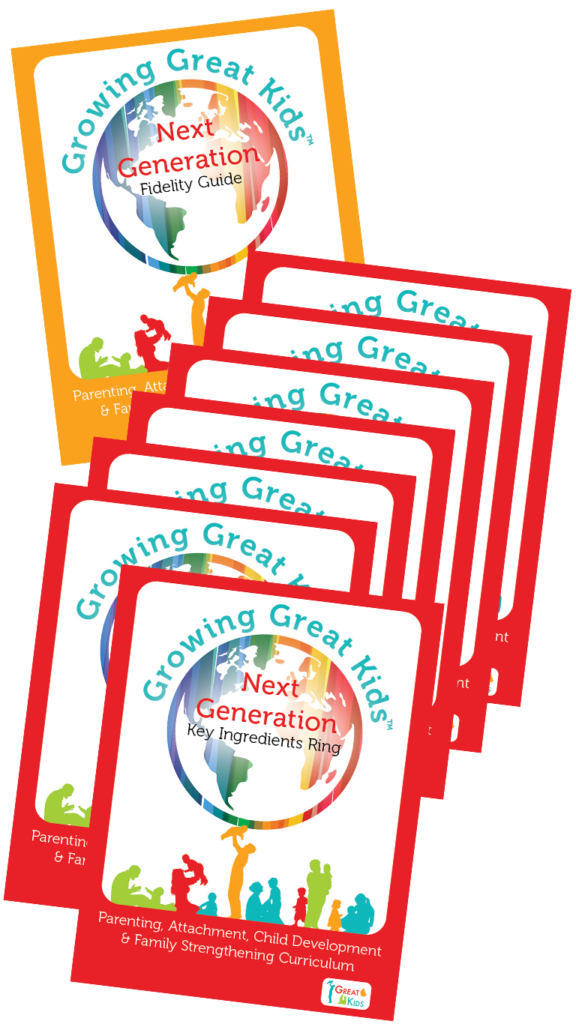Today’s blog will highlight a topic that comes up in GGK Seminars quite frequently — How to support 3-Generation Families. It’s not unusual for a home visitor to have several 3-Generation Families they visit who are looking for effective strategies for creating a healthier balance with care-giving tasks and relationships. We will enhance today’s discussion with the latest, relevant research pertaining to this topic and conclude with exploring the associated Growing Great Families resources and tools.
For the purpose of this discussion, let’s get started with some definitions. The term 3-Generation Family refers to multigenerational family households where two or more adult generations live together under the same roof; this generally includes a grandparent, parent, and child. Our definition also embraces multigenerational families where grandparents have major influences in caretaking and raising small children, even though all generations are not living together. According to the American Association of Retired Persons (AARP), there are strong indications that US and Canadian multigenerational living is on the rise. Approximately 51 million Americans, or 16.7 percent of the population, live in a house with at least two adult generations, or a grandparent and at least one other generation, under one roof. This trend is linked to cultures, such as Hispanic, Asian, and African American, who embrace multigenerational housing (AARP.org, April 2013).
It’s interesting to note that the 2010 US Census indicated that 7.5 million children lived with a grandparent in 2010; that’s about 10 percent of all children in the United States. Of these children, 4.9 million lived in the grandparent’s home. Additionally, among children younger than 5 whose mothers were employed, 30% were cared for, on a regular basis, by a grandparent during their mother’s working hours in 2005 (US Census.gov, 2010). Research indicates that the multigeneration housing phenomenon is increasing due to a variety of factors including economics, child care benefits, preventing elder isolation, family dysfunction connected to teen pregnancy, substance abuse, etc. PEW Charitable Trust research found that in 2015 the number of grandparents solely responsible for the care of grandchildren had risen to 2.9 million (Wiltz, 2016).
All this data resonates with the composition of today’s home visitor caseloads, doesn’t it? Most home visiting models are designed to integrate services focusing on addressing the needs of the whole family. This multigeneration approach supports inclusiveness of all family members from a programmatic and cultural perspective. However, it can sometimes be challenging for home visitors when it comes to addressing sensitive topics such as parenting, role clarification, making decisions about childcare practices— in other words, “who does what” when it comes to the baby and child care decisions, in addition to providing financial support and responsibility for other household tasks.
Your Growing Great Families manual includes two modules specific to 3-Generation Families. The modules are intentionally designed to approach sensitive intergenerational topics, while exploring strategies families might consider for promoting more harmony in their home. The conversation guides provided encourage families to reflect on how healthier relationships between parents and grandparents, and a better balance with caregiving might benefit the child and all of his/her caregivers. Let’s take a moment now to spotlight these modules:
- Becoming a 3-Generation Family- This module is the first in the series designed to explore initial feelings and concerns young parents and grandparents experience upon learning of an unexpected pregnancy; increase understanding and build a more positive relationship by pointing out common feelings and goals parents and grandparents have for the new baby; and to increase positive connections between parents and grandparents by sharing meaningful affirmations with each other. This Conversation Guide also incorporates a couple of handouts to support parents to give each other more affirmations and appreciation messages.
- Role Clarification in 3-Generation Families- This module is meant to be used as a follow up to the Becoming a 3-Generation Family and Protecting Your Children from Toxic Stress modules. This Conversation Guide explores several important topics including changing the “emotional tone” of relationships; old and new ways: making decisions about infant care; grandparenting styles; and role clarification. This module also includes great handouts to explore grandparenting styles and a plan for creating a healthier balance with caregiving.
Check-out this GGF 2 -Modules Series along with their corresponding handouts! Share with your families and remind them of the following:
“Children learn the most about life and how to live it from the day-to-day interactions they experience and observe as they grow up. Brain research has shown that an infant’s brain stores memories of all these experiences. We know positive memories will contribute to the child’s long-term happiness and success.”
Works Cited:
AARP.org (April 2013). Home and Family: Three Generations Under One Roof Bulletin by Sally Abrahms. Retrieved from http://www.aarp.org/home-family/friends-family/info-04-2013/three-generations-household-american-family.html.
US Census.gov (2010). Profile America Facts: Grandchildren. Retrieved from https://www.census.gov/newsroom/releases/archives/facts_for_features_special_editions/cb11-ff17.html
Wiltz, T. (2016, November 2). Why More Grandparents are Raising Children. Retrieved from PEW Charitable Trusts: http://www.pewtrusts.org/en/research-and-analysis/blogs/stateline/2016/11/02/why-more-grandparents-are-raising-children

